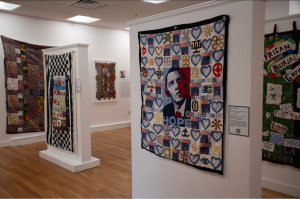
Quilting in Angola
An extraordinary humanitarian project has been on-going at the Louisiana State Prison for years now. That prison is commonly known as Angola, as that was the name of the slave plantation whose land it now occupies. Louise Kelleher was the co-founder of The Social Justice Quilts Project with Kenya Baleech Alkebu, who is incarcerated there. The project gives “inside quilters” and “outside quilters” an opportunity to work together (and for some, to receive quilting guidance from the “outside quilters”).
Mr. Alkebu was making quilts for people receiving end of life care in the prison’s hospice program. He has been incarcerated at Angola for 44 years and quilting became part of his lifestyle. Ms. Kelleher, also a quilter, found out about his work and desired to aid the Angola Hospice Program – both those dying in prison and those who love them. Those inside the prison have limited access to quilting material and stuck together scraps of fabric. She was struck by the combination of art and care she saw in the hospice program. In this, she saw wonderful humanitarian work being done, all from inside the prison.
There are now about 18 “inside quilters” and 4 “outside quilters” and, like the quilters of Gee’s Bend, a group of formerly enslaved African-American women from an isolated part of Alabama in the 1800s, whose work was recently on display at the Boston MFA, this work is noteworthy and striking, both in intellectual and visual content. A group of the quilts are currently on tour around the US. The show, called “Stitching Time”, was on view at UMass – Amherst earlier this year and on display in a museum in Oak Bluffs on Martha’s Vineyard until October 9. Some of the quilts have political themes, others are just abstract beauties, but all speak to redemption.
Fluidity
My brother, Rabbi Richard Sarason, and sister-in-law, Anne Arenstein, live in Cincinnati, where my brother has taught at Hebrew Union College for over four decades. Annie has been involved in the rich arts community, doing both museum education work and writing about the cultural life for various magazines and papers.
They currently sing with a choral group called “Fluidity”. Its mission, aside from being welcoming and inclusive, is to pick a worthy local non-profit for each concert cycle, raise funds and awareness for it. The chorus learns about the group and tailors its music to highlight the non-profit work being done. Their latest concert benefitted the Ohio Innocence Project, which works to exonerate and free wrongfully convicted people from the morass of the prison system (in this case, they work just in Ohio).
I have linked to two important pieces, provided by my sister-in-law. One is a snippet of that recent concert, including some music as well as interviews with members of the chorus, as well as a man exonerated by the Ohio Innocence Project and the leader of the Ohio Innocence Project. The second is an article Annie wrote several years ago about an opera written about the Ohio Innocence Project. Both are worth your time.
Arts of all kind can be used to make a difference in prisoners’ lives.
Retired from software sales long ago, two grown children. Theater major in college. Singer still, arts lover, involved in art museums locally (Greater Boston area). Originally from Detroit area.




Wonderful Betsy! Thanx for your two stories, and bravo to your brother and sister-in-law.
My Prison story too reminds us how the arts can make a difference to the incarcerated.
It is true, Dana. I think arts can make a difference in almost anyone’s life, if they can be open to them. I was blown away when Annie sent me those links and asked her permission to use them for this prompt. She gladly granted it. What great work they are doing!
Betsy: I visited the Stitching Time exhibition in Washington DC. I stayed for a few hours of history I had never witnessed.
Would they use ties? As I am swarming through my years of their collection, I have wondered who would want them. Some are artistic, others are quite common. I think I have over 50. I would like to put them to good use rather than in the dumpster.(My son in law does not wear ties.)
I don’t know if your ties could be useful or not. You’d have to get in touch with the quilters at Angola, but I would think the fabric would work.
How interesting that you’ve seen the exhibit!
PS I may have seen another exhibit. It featured the quilting and design by female slaves for their masters who were given credit for the work.
It seems that slave owners frequently appropriated everything done by those they enslaved. That’s why there is talk of reparations.
Wonderful project. Funny how programs that give access to the arts, literacy, learning and service to others can be so healing—as opposed to the misery of counterproductive punishment. Thanks for sharing the information and insights.
Thanks for taking the time to read this and respond, Khati. I always appreciate your insight.
Thank you for sharing the concert highlights and the photos of the beautiful quilts. This is an amazing project. Kudos to your brother and sister-in-law for doing this important work.
Thank you for these comments, Laurie. Both of the projects I highlighted felt appropriate for the prompt and meaningful. In email conversation with my sister-in-law a few weeks ago (after the Community prompt), she told me about Fluidity’s recent work. I told her it would be perfect for this upcoming prompt and asked for permission to share it with our community, which she gladly granted. I’m so pleased that I can share it with a wider community!